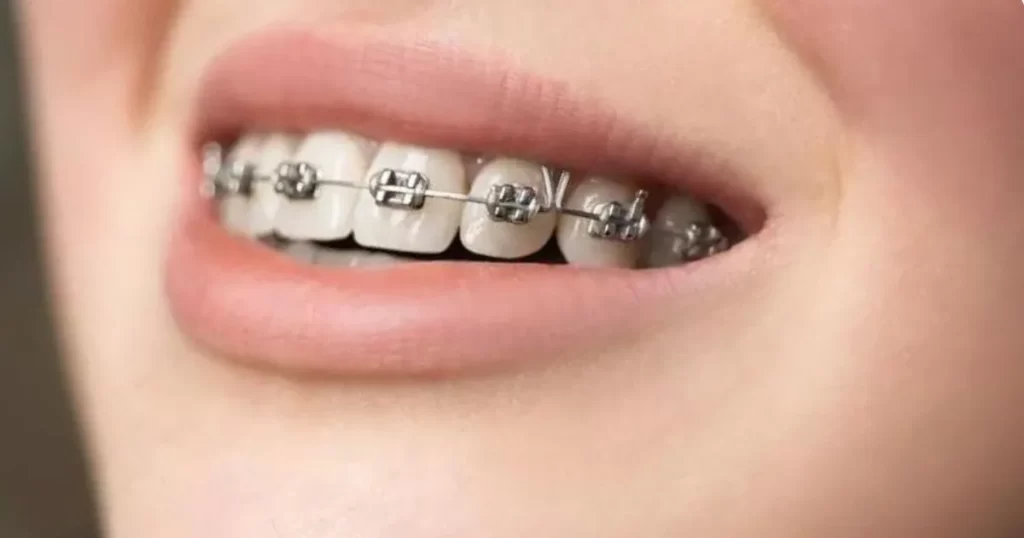Metal Braces
- Home
- Dental Braces
- Metal Braces
Metal braces, also known as classic braces, are the most prevalent form of braces used worldwide and have been in use for over a century. Braces used to be fairly large and conspicuous. Luckily, braces today are nothing like what they were 100 years ago. Advances in innovation and technology have made braces:
Smaller
Faster
More Comfortable
More Effective

Children and adolescents are the most likely to use metal braces. They function by attaching braces to the teeth and connecting them with a wire. The wire is attached to the braces via elastic ties, which come in a variety of colors. At your checkups every 4-8 weeks, the orthodontist adjusts the wire to reposition the teeth.
Unlike removable transparent aligners such as Invisalign, some parents and patients choose metal braces since they do not need their kid to wear them. Metal braces, on the other hand, need care and attention, and proper dental hygiene is essential during therapy.
When it comes to orthodontic treatment, metal braces are one of the most common and effective options available. Metal braces have been used for decades to help straighten teeth and correct various dental problems. In this article, we will explore everything you need to know about metal braces, including their benefits, how they work, the different types of metal braces available, and what to expect during treatment.
Pros
Metal braces offer several benefits that make them a popular choice for patients seeking orthodontic treatment. Here are some of the key advantages of metal braces:
- Efficient and versatile
- No speech changes
- Appointments every 4-8 weeks
- Fun if you want colors
- Less reliant on patient compliance than Invisalign
- No waiting period to get started
- Most affordable
Cons
- Difficult to brush and floss
- Most noticeable esthetically
- Not for patients with poor oral hygiene
Metal braces work by applying pressure to the teeth, gradually moving them into the correct position. This is achieved through a system of brackets, archwires, and elastics.
The brackets are attached to the teeth using a special adhesive, and the archwire is threaded through the brackets. The elastics are then used to hold the archwire in place.
The orthodontist will adjust the archwire periodically throughout the treatment process, applying more pressure to move the teeth into the correct position. This process typically takes between 18 and 24 months, depending on the severity of the dental problem.
Metal braces offer several benefits that make them a popular choice for patients seeking orthodontic treatment. Here are some of the key advantages of metal braces:
Effective: Metal braces are one of the most effective methods for correcting dental problems such as crooked teeth, gaps, and bite issues. They apply constant pressure to teeth, gradually moving them into the correct position.
Versatile: Metal braces can be used to treat a wide range of dental problems, from minor issues such as slightly crooked teeth to more complex problems such as malocclusion.
Affordable: Compared to other types of orthodontic treatment, metal braces are often more affordable, making them a good option for patients on a budget.
Durable: Metal braces are made from high-quality materials that are designed to last throughout the entire treatment process.
If you decide to get metal braces, here is what you can expect during the treatment process:
Consultation: The first step in getting metal braces is to schedule a consultation with an orthodontist. During this appointment, the orthodontist will examine your teeth, take x-rays, and develop a treatment plan.
Braces Placement: Once your treatment plan is finalized, the orthodontist will place the brackets on your teeth using a special adhesive. This process is painless and typically takes about an hour.
Adjustments: Over the course of your treatment, you will need to visit your orthodontist regularly for adjustments. During these appointments, the orthodontist will tighten the archwire to apply more pressure to your teeth, gradually moving them into the correct position.
Oral Hygiene: Proper oral hygiene is essential during orthodontic treatment, especially when it comes to metal braces. You will need to brush and floss your teeth regularly to prevent plaque buildup and keep your braces and teeth clean.
Diet Restrictions: During treatment, you will need to avoid certain foods that can damage your braces or make it harder to keep your teeth clean. These include hard, sticky, or chewy foods.
Discomfort: It is normal to experience some discomfort during the first few days after getting metal braces and after each adjustment. This discomfort can be managed with over-the-counter pain medication and will usually subside within a few days.
Treatment Completion: Once your teeth have been moved into the correct position, your orthodontist will remove your braces. You will then be given a retainer to wear to help maintain the results of your treatment.
Proper care of your metal braces is essential for successful treatment. Here are some tips to help you care for your metal braces:
Brush and floss regularly: You should brush your teeth at least twice a day and floss once a day to prevent plaque buildup and keep your braces and teeth clean.
Use a mouthwash: Mouthwash can help kill bacteria and freshen your breath.
Avoid certain foods: Hard, sticky, and chewy foods can damage your braces or make it harder to keep your teeth clean.
Wear a mouthguard: If you play sports, wear a mouthguard to protect your braces and teeth.
Attend all scheduled appointments: Regular adjustments are essential to the success of your treatment.
Metal braces are a highly effective and affordable option for correcting dental problems such as crooked teeth, gaps, and bite issues. They work by applying pressure to the teeth, gradually moving them into the correct position. There are several types of metal braces available, each with its own unique advantages and disadvantages. Proper care of your metal braces is essential for successful treatment, including regular brushing and flossing, avoiding certain foods, and attending all scheduled appointments. If you are considering metal braces, talk to your orthodontist to learn more about your options and what to expect during treatment.

